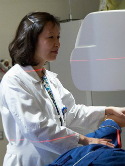A novel respiratory tracking system for smart-gated PET acquisition Journal Article
| Authors: | Nehmeh, S. A.; Haj-Ali, A. A.; Qing, C.; Stearns, C.; Kalaigian, H.; Kohlmyer, S.; Schoder, H.; Ho, A. Y.; Larson, S. M.; Humm, J. L. |
| Article Title: | A novel respiratory tracking system for smart-gated PET acquisition |
| Abstract: | Purpose: In this study, the authors validated a novel respiratory tracking device, the multidimensional respiratory tracking (MDRT) system, that was designed to assist in correcting for respiratory motion in PET/CT images. The authors also investigated a novel PET acquisition technique, smart gating (SG), that enables to acquire motion-free PET data prospectively, with minimum user interference and with no additional postprocessing of the PET data. Methods: MDRT uses visual tracking techniques to track simultaneously the two-dimensional (in the vertical plane) motion of multiple fiducial markers using a standard video camera. A threshold window is set at the breathing amplitude of interest using the MDRT GUI. A trigger is generated at a rate of 250 Hz as long as the breathing signal is within the threshold window. The triggers are fed into the PET scanner to initialize one single bin of a gated acquisition every 4 ms. No triggers are delivered as the breathing signal drifts outside the threshold window. Consequently, PET data are acquired only whenever the breathing signal is confined within the amplitude threshold window, thus resulting into a motion-free image set. The accuracy of MDRT in tracking the breathing signal was assessed (1) by comparing the period of an oscillating phantom, as measured by MDRT, to that measured with a photogate timer and (2) by comparing the MDRT output to that of the real-time position management (RPM) in ten patients. The SG PET/CT acquisition was validated in phantoms and in two stereotactic body radiosurgery (SBRS) lung DIBH-PET/CT patients. Results: MDRT was in agreement with the photogate timer in determining the period of motion to less than 2%. The percent errors between MDRT and RPM in the positions of the peaks and troughs of the ten patients' breathing signals were within 10%. In phantoms, SG technique enables to correct for motion-induced artifacts in the PET images and improve the accuracy of PET quantitation. For the SBRS application, in one patient, the patient's CT lesion was not detected in the corresponding clinical PET images, while it exhibited an SUV of 1.8 in the DIBH image set. In the second patient, DIBH-PET images showed an improved PET-to-CT spatial matching and a 52% increase in the lesion SUV. Conclusions: MDRT has been shown to be accurate in tracking breathing motion and assisted in implementing a smart-gating PET acquisition technique that allowed to acquire prospectively motion-free PET images. © 2011 American Association of Physicists in Medicine. |
| Keywords: | pet/ct; dibh; smart-gating |
| Journal Title: | Medical Physics |
| Volume: | 38 |
| Issue: | 1 |
| ISSN: | 0094-2405 |
| Publisher: | American Association of Physicists in Medicine |
| Date Published: | 2011-01-01 |
| Start Page: | 531 |
| End Page: | 538 |
| Language: | English |
| DOI: | 10.1118/1.3523100 |
| PROVIDER: | scopus |
| PUBMED: | 21361220 |
| DOI/URL: | |
| Notes: | --- - "Export Date: 4 March 2011" - "CODEN: MPHYA" - "Source: Scopus" |
Altmetric
Citation Impact
BMJ Impact Analytics
Related MSK Work








